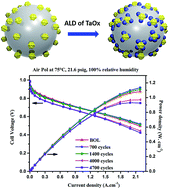Atomic layer deposited tantalum oxide to anchor Pt/C for a highly stable catalyst in PEMFCs†
Abstract
Tantalum oxide (TaOx) nanoparticles (NPs) are deposited on a commercial Pt/C catalyst by an area-selective atomic layer deposition (ALD) approach to enhance the stability of the catalyst in proton exchange membrane fuel cells (PEMFCs). Due to the application of a blocking agent for protecting the Pt surface, TaOx particles are selectively nucleated and grown around Pt NPs. The TaOx loading on the Pt/C surface could be controlled precisely by varying the number of ALD cycles. When deposited on the Pt/C surface with 35 ALD cycles, the TaOx-anchored Pt NPs formed an excellent triple-junction structure of TaOx–Pt–carbon. The electrochemical durability tests indicated that the TaOx-anchored Pt/C catalyst showed comparable catalytic activity and superior long-term stability to Pt/C. Moreover, the long-term stability test in membrane electrode assembly (MEA) indicated a very low power density loss (12%) after a 120 h accelerated durability test. The significantly enhanced catalyst stability during PEMFCs operation is due to the anchoring effect of TaOxvia strong metal oxide–support interactions. This strategy shows great potential for developing highly stable catalysts for PEMFCs.



 Please wait while we load your content...
Please wait while we load your content...